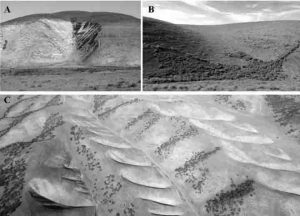
If you ever fly from L.A. to San Francisco, California, you may notice the Gabilan Mesa off to the east as you begin your descent into San Francisco International Airport. If you look carefully, you might notice two strange things: a series of bleach-white scars, where rock outcrops disrupt the smooth, grassy hillslopes, and a strong asymmetry in the orientation of tributaries, with many flowing south and few flowing north.
What you can’t see is the few feet of soil that would lie beneath your feet if you were standing on the surface — but it turns out that soil column may have a lot to do with shaping your 10,000-foot view.
Over long time scales, the transition from hillslopes to channels is controlled by the relative efficiencies of soil transport and channel erosion. This transition usually remains stable when erosion rates change, because increases in erosion rate would typically expose rocks that are stronger than the overlying weathered soils, thereby slowing any further increase in erosion rate. But what would happen if the opposite were true, if increases in erosion rates exposed highly vulnerable rocks, causing an unstable increase in erosion rate?
In this scenario, the shape of the landscape would be fragile — susceptible to major reconfigurations in the face of small changes in erosion rate. In their paper for the Geological Society of America Bulletin, Samuel Johnstone and colleagues demonstrate that this may be the case in landscapes developed in rock types that are susceptible to slaking, a process that pervasively fractures these rocks when they are exposed to wetting and drying cycles.
Using laboratory measures of rock strength, Johnstone and colleagues demonstrate that soils in the Gabilan Mesa, California, are actually stronger than the rocks from which they were derived, once those parent rocks have been exposed to a single wetting and drying cycle.
Within the Gabilan Mesa, these rocks are typically covered in soil, but can be exposed in dramatic erosional channel features called arroyos. The morphology of arroyos and their position in the landscape suggests that they form by aggressively cutting uphill into the soil mantled hillslopes. Theory predicts that this behavior would be expected in an unstable erosion scenario.
What is perhaps most interesting is how climate influences the fragile landscape response recorded by arroyos. Arroyos are exclusively found within south-flowing catchments, and Johnstone and colleagues reason that this is the consequence of the thinner layer of soil that forms on these sunnier, drier, more poorly vegetated slopes. These thin soils allow highly erodible bedrock to be more readily accessed by erosive processes, and arroyos to be triggered more easily. This asymmetric triggering of headward (upslope) channel growth appears to drive profound topographic asymmetry, in which drainages are densely packed on south-facing slopes and nearly absent on north-facing slopes. This pattern is observable at the scale of entire drainage basins. The team’s observations suggest that this large-scale reorganization of the Gabilan Mesa landscape starts with the soils, and the unusual combination of relatively strong soils forming from easily weakened rocks.
Note: The above post is reprinted from materials provided by Geological Society of America.










